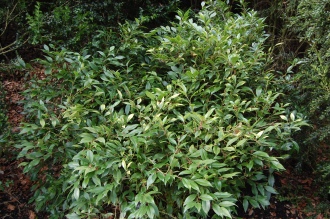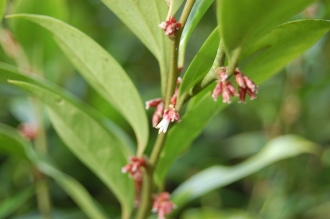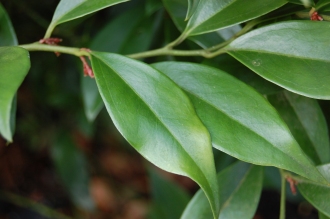Position: Dappled to full shade
Flowering period: Late winter
Soil: Moist but well drained
Eventual Height: 1m
Eventual Spread: 1m
Hardiness: 6b, 7a, 7b, 8a, 8b, 9a, 9b, 10a 10b
Family: Buxaceae
Sarcococca orientalis is a slow growing, evergreen shrub with a bushy habit. Its dark green glossy leaves are ovate to lanceolate with entire margins, up to 9cm long and 3cm broad. Its fragrant white/ pink tinged flowers are produced in the axils of the leaves. The female flowers are produced below the male flowers. The female flowers are then followed by fleshy black berries.
Sarcococca orientalis, commonly known as Christmas Box or Sweet Box, is native to south east China. In its native habitat it grows in forests and stream banks.
The etymological root of the binomial name Sarcococca is derived from the Greek sarx ’flesh’ and kokkos ’berry’. Orientalis is from the Latin meaning ‘from the East’.
The landscape architect may find Sarcococca orientalis useful as a low growing, evergreen shade tolerant shrub, including in the dry shade of tree. It produces fragrant flowers during the winter months. It may be used as a formal or informal hedging plant. Once established this shrub is drought tolerant.
Ecologically, Sarcococca orientalis is valuable as it attracts birds to the berries and is an excellent source of winter nectar for insects.
Sarcococca orientalis prefers moist, humus rich, moderately fertile, well-drained soils. It tolerates most pH of soil. It will tolerate dry shady soils.
Sarcococca orientalis requires little maintenance. If required pruning should be carried out after flowering.













